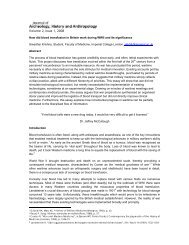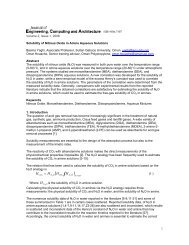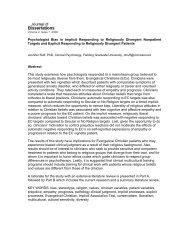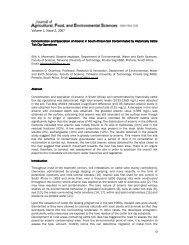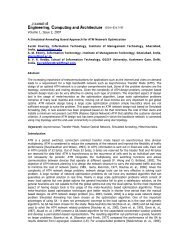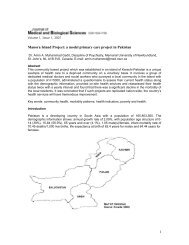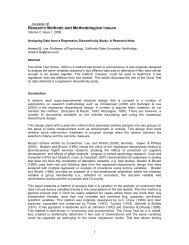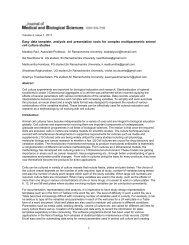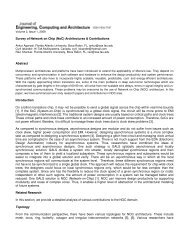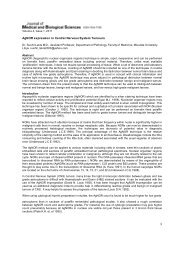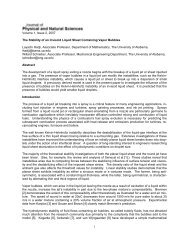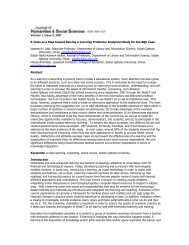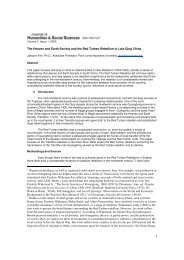Identifying Predictors of Active Coping in Different Stressful Situations
Identifying Predictors of Active Coping in Different Stressful Situations
Identifying Predictors of Active Coping in Different Stressful Situations
Create successful ePaper yourself
Turn your PDF publications into a flip-book with our unique Google optimized e-Paper software.
Volume 2, Issue 1, 2008<br />
Help<strong>in</strong>g College Students Cope: <strong>Identify<strong>in</strong>g</strong> <strong>Predictors</strong> <strong>of</strong> <strong>Active</strong> <strong>Cop<strong>in</strong>g</strong> <strong>in</strong> <strong>Different</strong><br />
<strong>Stressful</strong> <strong>Situations</strong><br />
M<strong>in</strong>g-hui Li<br />
Assistant Pr<strong>of</strong>essor, St. John’s University, Department <strong>of</strong> Human Services and Counsel<strong>in</strong>g,<br />
Queens, NY, lim@stjohns.edu<br />
Abstract<br />
College students may encounter stressful situations related to relationships, work, and academia.<br />
The tendency to actively cope (active cop<strong>in</strong>g) plays a significant role <strong>in</strong> the process <strong>of</strong> adapt<strong>in</strong>g to<br />
stressful situations. This study explored predictors <strong>of</strong> active cop<strong>in</strong>g <strong>in</strong> three situations.<br />
Participants were 219 Taiwanese college students (192 females and 27 males). The most<br />
effective predictor <strong>of</strong> active cop<strong>in</strong>g <strong>in</strong> relationship-related situations and work-related situations<br />
were resilience ( β = .38) and secure attachment ( β = .50), respectively. No effective predictor <strong>of</strong><br />
active cop<strong>in</strong>g was identified <strong>in</strong> the academic-related stressful situations. The article ends by<br />
<strong>of</strong>fer<strong>in</strong>g implications <strong>of</strong> this study’s f<strong>in</strong>d<strong>in</strong>gs.<br />
Introduction<br />
College students may experience stressful situations associated with <strong>in</strong>terpersonal relationships,<br />
work, and academia (Bolger, 1997; Kariv & Heiman, 2005; Chang, 1998; Lounsbury, Huffstetler,<br />
Leong, & Gibson, 2005; Moller, McCarthy, & Fouladi, 2002; Rao, 2000). Not all college students<br />
adapt at the same rate and with the same outcome. Researchers have explored the process by<br />
which people adapt to stressful situations (Banyard & Cantor, 2004; Kumpfer, 1999; Rutter, 1987;<br />
Woodhead, 1995; Wyman, Sandler, Wolchik, & Nelson, 2000). F<strong>in</strong>d<strong>in</strong>gs suggest “active cop<strong>in</strong>g,”<br />
specifically, plays a significant role <strong>in</strong> the process <strong>of</strong> adapt<strong>in</strong>g to stressful situations (Kumpfer,<br />
1999). <strong>Active</strong> cop<strong>in</strong>g affects <strong>in</strong>dividuals’ causal attributions and help-seek<strong>in</strong>g behaviors <strong>in</strong> the<br />
process <strong>of</strong> adapt<strong>in</strong>g to stressful situations (Pizzolato, 2004), and therefore active cop<strong>in</strong>g is related<br />
to positive adaptation to college life (Feenstra, Banyard, R<strong>in</strong>es, & Hopk<strong>in</strong>s, 2001). <strong>Active</strong> cop<strong>in</strong>g<br />
<strong>in</strong> this study is def<strong>in</strong>ed as people’s cop<strong>in</strong>g style that is characterized by solv<strong>in</strong>g problems, seek<strong>in</strong>g<br />
social support, mak<strong>in</strong>g some positive mean<strong>in</strong>g out <strong>of</strong> experiences, attempt<strong>in</strong>g to alter stressful<br />
situations, and non-avoidance.<br />
<strong>Active</strong> cop<strong>in</strong>g has been extensively studied and a variety <strong>of</strong> factors such as optimism, burnout,<br />
sense <strong>of</strong> mastery, previous cop<strong>in</strong>g experiences, threat appraisal, climate, occupational status,<br />
and power differential have been found to determ<strong>in</strong>e this cop<strong>in</strong>g style (Armstrong-Stassen, 1994;<br />
Bernier, 1998; Brennan, Schutte, & Moos, 2006; Chung, Langenbucher, Labouvie, Pand<strong>in</strong>a, &<br />
Moos, 2001; Malamut & Offermann, 2001). Although determ<strong>in</strong>ants <strong>of</strong> active cop<strong>in</strong>g have been<br />
studied <strong>in</strong> the university sett<strong>in</strong>g (McGown & Fraser, 1995; Zeidner, 1994), less work has been<br />
devoted to explore determ<strong>in</strong>ants <strong>of</strong> college students’ active cop<strong>in</strong>g across different stressful<br />
situations. This study seeks to fill that gap <strong>in</strong> the literature. In particular, this study explored<br />
determ<strong>in</strong>ants <strong>of</strong> college students’ active cop<strong>in</strong>g <strong>in</strong> stressful situations related to <strong>in</strong>terpersonal<br />
relationships, work, and academia. In this study, <strong>in</strong>terpersonal relational situations that directly<br />
impact <strong>in</strong>dividuals, such as arguments with boy- or girlfriends, were categorized as high-stress<br />
relational situations. On the other hand, <strong>in</strong>terpersonal relational situations that <strong>in</strong>directly impact<br />
<strong>in</strong>dividuals, such as worry about arguments between other classmates, were considered as lowstress<br />
relational situations.<br />
The purpose <strong>of</strong> this study was to identify the perception-related traits that can effectively <strong>in</strong>fluence<br />
college students to actively cope with three categories <strong>of</strong> stressful situation: situations related to<br />
1
<strong>in</strong>terpersonal relationships, work, and academia. In this study, three perception-related traits—the<br />
trait <strong>of</strong> resilience, secure attachment, and self-efficacy—were applied to predict active cop<strong>in</strong>g <strong>in</strong><br />
the three categories <strong>of</strong> stressful situations. The rationale for us<strong>in</strong>g perception-related traits to<br />
predict active cop<strong>in</strong>g will be discussed <strong>in</strong> the Theoretical Framework section.<br />
This study’s f<strong>in</strong>d<strong>in</strong>gs may better <strong>in</strong>form college counselors and adm<strong>in</strong>istrators so they can help<br />
their students cope more effectively with college life. For example, one previous study (Myers &<br />
Vetere, 2002) noted that students with a secure attachment pattern reported hav<strong>in</strong>g more social<br />
and emotional resources, resources which are related to active cop<strong>in</strong>g. Their study implied that<br />
students with secure attachment patterns tend to actively cope with stressful situations. If this<br />
study’s f<strong>in</strong>d<strong>in</strong>gs also show that secure attachment is predictive <strong>of</strong> active cop<strong>in</strong>g, then college<br />
counselors and adm<strong>in</strong>istrators can more confidently address their students’ levels <strong>of</strong> secure<br />
attachment <strong>in</strong> order to help them actively cope with college stressors and adapt better to college<br />
life. This study further contributes to the field <strong>of</strong> college counsel<strong>in</strong>g by study<strong>in</strong>g major collegiate<br />
stressful situations <strong>in</strong> the same study. As mentioned earlier, although scholars such as McGown<br />
and Fraser (1995) explored determ<strong>in</strong>ants <strong>of</strong> active cop<strong>in</strong>g <strong>in</strong> college students, few researchers<br />
have explored the stability <strong>of</strong> determ<strong>in</strong>ants <strong>of</strong> active cop<strong>in</strong>g <strong>in</strong> such students across major<br />
college-related stressful situations.<br />
Variables Involved <strong>in</strong> the Framework<br />
<strong>Active</strong> cop<strong>in</strong>g is def<strong>in</strong>ed <strong>in</strong> this study as people’s cop<strong>in</strong>g style that is characterized by solv<strong>in</strong>g<br />
problems, seek<strong>in</strong>g social support, mak<strong>in</strong>g some positive mean<strong>in</strong>g out <strong>of</strong> experiences, attempt<strong>in</strong>g<br />
to alter stressful situations, and non-avoidance.<br />
The trait <strong>of</strong> resilience has been def<strong>in</strong>ed as “personality characteristics that moderates the<br />
negative effects <strong>of</strong> stress and promotes adaptation” (Wagnild & Young, 1993, p. 165). Previous<br />
studies <strong>in</strong>dicated that resilient <strong>in</strong>dividuals have a positive view <strong>of</strong> stressful situations and they<br />
tend to actively cope with stressful situations (Banyard & Cantor, 2004; Parr, Montgomery, &<br />
DeBell, 1998; Qu<strong>in</strong>ton, Pickles, Maughan, & Butter, 1993; Rutter, Qu<strong>in</strong>ton, & Hill, 1990). These<br />
studies implied that the trait <strong>of</strong> resilience <strong>in</strong>fluences people to actively cope with stressful<br />
situations. This study exam<strong>in</strong>ed this hypothesis by explor<strong>in</strong>g the extent to which the trait <strong>of</strong><br />
resilience can <strong>in</strong>fluence people to cope actively with different types <strong>of</strong> stressful situations.<br />
Secure attachment refers to a cognitive schema that guides <strong>in</strong>dividuals to believe it is relatively<br />
easy to form close relationships with others and to feel at ease <strong>in</strong> rely<strong>in</strong>g on others (Hazan &<br />
Shaver, 1987). Secure attachment is a trait that leads <strong>in</strong>dividuals to form positive perceptions<br />
about themselves and the world (Bowlby, 1969). This trait is relation-related; it develops <strong>in</strong> social<br />
<strong>in</strong>teractions and it <strong>in</strong>fluences children’s later social lives (Bowlby, 1969). Kumpfer (1999)<br />
proposed that secure attachment experiences <strong>in</strong>fluence stress-cop<strong>in</strong>g process. Her proposal has<br />
been supported by Banyard and Cantor’s (2004) f<strong>in</strong>d<strong>in</strong>g that college students with secure<br />
attachment tend to adapt well to college stressors. Although the effect <strong>of</strong> secure attachment on<br />
active cop<strong>in</strong>g seems to be positive <strong>in</strong> relation-related stressful situations, the extent to which it<br />
<strong>in</strong>fluences active cop<strong>in</strong>g <strong>in</strong> other types <strong>of</strong> stressful situations has not been well explored. This<br />
study addressed this issue.<br />
Self-efficacy refers to people’s beliefs <strong>in</strong> hav<strong>in</strong>g control over their own function<strong>in</strong>g and over what<br />
occurs <strong>in</strong> the environment (Bandura, 1977). Self-efficacy has been considered a stable trait that<br />
leads <strong>in</strong>dividuals to believe that they are able to manage stressful situations <strong>in</strong> their lives (Sherer<br />
& Maddux, 1982). Bandura believes that self-efficacy <strong>in</strong>volves behavioral tasks and is a<br />
performance-related belief; therefore, it is expected to lead <strong>in</strong>dividuals to actively cope with<br />
performance-related stressful situations. However, one cannot afford to rule out the possibility<br />
that self-efficacy determ<strong>in</strong>es active cop<strong>in</strong>g <strong>in</strong> non-performance-related stressful situations. This<br />
study explored the effect <strong>of</strong> self-efficacy on active cop<strong>in</strong>g <strong>in</strong> different types <strong>of</strong> stressful situations.<br />
2
Theoretical Framework<br />
Kumpfer (1999) proposed that <strong>in</strong>dividuals experience a person-environment transactional process<br />
when they encounter stressful situations, and she further suggested that this process is<br />
<strong>in</strong>fluenced by environmental contexts and personal resiliency factors. Major factors <strong>in</strong> the personenvironment<br />
transactional process <strong>in</strong>clude (a) perception, (b) refram<strong>in</strong>g, (c) chang<strong>in</strong>g<br />
environments, and (d) active cop<strong>in</strong>g. Perception refers to the way that people view a stressful<br />
situation. For example, some straight-A students view a hard f<strong>in</strong>al exam<strong>in</strong>ation as a threat to their<br />
excellent academic history. Refram<strong>in</strong>g refers to people’s tendency to change the mean<strong>in</strong>g <strong>of</strong> a<br />
stressful situation. For example, <strong>in</strong>stead <strong>of</strong> call<strong>in</strong>g themselves a victim <strong>of</strong> a relational break-up,<br />
some people call themselves a survivor. Chang<strong>in</strong>g environments refers to people’s efforts to<br />
change someth<strong>in</strong>g <strong>in</strong> their surround<strong>in</strong>g. For example, some people deliberately do groceryshopp<strong>in</strong>g<br />
at a different supermarket when they want to make a change <strong>in</strong> life. <strong>Active</strong> cop<strong>in</strong>g refers<br />
to people’s cop<strong>in</strong>g strategies that are characterized by solv<strong>in</strong>g problems, seek<strong>in</strong>g social support,<br />
mak<strong>in</strong>g some positive mean<strong>in</strong>g out <strong>of</strong> experiences, and attempt<strong>in</strong>g to alter stressful situations.<br />
For example, some people voluntarily seek for pr<strong>of</strong>essional help <strong>in</strong> order to deal with test anxiety.<br />
If refram<strong>in</strong>g and chang<strong>in</strong>g the environment are seen as two forms <strong>of</strong> active cop<strong>in</strong>g, then the<br />
person-environment transactional process referenced <strong>in</strong> Kumpfer’s study can be regarded as the<br />
<strong>in</strong>teraction between perception and active cop<strong>in</strong>g. Therefore, <strong>in</strong> explor<strong>in</strong>g the <strong>in</strong>teraction <strong>of</strong> factors<br />
<strong>in</strong> the person-environment transactional process, the author focused on exam<strong>in</strong><strong>in</strong>g the<br />
relationship between perception and active cop<strong>in</strong>g. This exam<strong>in</strong>ation focused on relationshiprelated,<br />
work-related, and academia-related stressful situations because they are three major<br />
types <strong>of</strong> stressful situations faced by college students (Bolger, 1997; Kariv & Heiman, 2005;<br />
Chang, 1998; Lounsbury, Huffstetler, Leong, & Gibson, 2005; Moller, McCarthy, & Fouladi, 2002;<br />
Rao, 2000).<br />
Lazarus (1999) stated that <strong>in</strong>dividuals’ beliefs about self and the world may <strong>in</strong>fluence cop<strong>in</strong>g<br />
process. It appears that factors related to <strong>in</strong>dividuals’ beliefs about self and the world can<br />
<strong>in</strong>fluence their perceptions <strong>of</strong> stressful situations. S<strong>in</strong>ce the primary issue addressed <strong>in</strong> the study<br />
is the relationship between perception and active cop<strong>in</strong>g under stressful situations, the author<br />
assumed that traits that <strong>in</strong>fluence <strong>in</strong>dividuals’ perceptions <strong>of</strong> stressful situations can <strong>in</strong>fluence<br />
<strong>in</strong>dividuals to cope actively with stressful situations. Based on that assumption, the author<br />
hypothesized that perception-related traits such as the trait <strong>of</strong> resilience, secure attachment, and<br />
self-efficacy can predict active cop<strong>in</strong>g. The hypothesis was then tested <strong>in</strong> three different types <strong>of</strong><br />
stressful situations related to relationships, work, and academia. Specifically, the follow<strong>in</strong>g<br />
hypotheses were tested.<br />
Hypothesis 1:<br />
Hypothesis 2:<br />
Hypothesis 3:<br />
Hypothesis 4:<br />
There is a significant relationship between active cop<strong>in</strong>g and a<br />
l<strong>in</strong>ear comb<strong>in</strong>ation <strong>of</strong> trait <strong>of</strong> resilience, secure attachment, and<br />
self-efficacy <strong>in</strong> low stress situations associated with relationships.<br />
There is a significant relationship between active cop<strong>in</strong>g and a<br />
l<strong>in</strong>ear comb<strong>in</strong>ation <strong>of</strong> trait <strong>of</strong> resilience, secure attachment, and<br />
self-efficacy <strong>in</strong> high stress situations associated with relationships.<br />
There is a significant relationship between active cop<strong>in</strong>g and a<br />
l<strong>in</strong>ear comb<strong>in</strong>ation <strong>of</strong> trait <strong>of</strong> resilience, secure attachment, and<br />
self-efficacy <strong>in</strong> stressful situations associated with work.<br />
There is a significant relationship between active cop<strong>in</strong>g and a<br />
l<strong>in</strong>ear comb<strong>in</strong>ation <strong>of</strong> trait <strong>of</strong> resilience, secure attachment, and<br />
self-efficacy <strong>in</strong> stressful situations associated with academia.<br />
3
Methods<br />
Participants<br />
Two hundred and n<strong>in</strong>eteen college students (192 females and 27 males) were recruited from a<br />
college <strong>in</strong> Taiwan. Participants’ age ranged from 18 to 23 years old. The mean age <strong>of</strong> this sample<br />
was 20.1. All participants were Han Ch<strong>in</strong>ese, the major ethnic group <strong>in</strong> Taiwan.<br />
Instruments<br />
Data were collected us<strong>in</strong>g a questionnaire that consists <strong>of</strong> six sections: demographic <strong>in</strong>formation,<br />
the <strong>Cop<strong>in</strong>g</strong> Strategy Indicator (CSI: Amirkhan, 1990a), the Resilience Scale (RS: Wagnild &<br />
Young, 1993), the Revised Adult Attachment Scale (AAS-Revised: Coll<strong>in</strong>s, 1996), the Ch<strong>in</strong>ese<br />
Adaptation <strong>of</strong> General Self-Efficacy Scale (GSS: Zhang & Schwarzer, 1995), and the Student-Life<br />
Stress Inventory (Gadzella, 1991). All <strong>of</strong> the <strong>in</strong>struments have been used to study college<br />
students and have demonstrated adequate validity (construct or concurrent validity) and reliability<br />
(Cronbach’s coefficient alpha range from .76 to .93).<br />
The <strong>Cop<strong>in</strong>g</strong> Strategies Indicator (CSI).<br />
The <strong>Cop<strong>in</strong>g</strong> Strategy Indicator (Amirkhan, 1990a) is a 33-item, three-po<strong>in</strong>t Likert-type scale. The<br />
CSI has three subscales: problem solv<strong>in</strong>g, seek<strong>in</strong>g social support, and avoidance. Amirkhan<br />
(1990a) reported good <strong>in</strong>ternal consistency for the three subscales <strong>of</strong> the CSI. The Cronbach’s<br />
alpha coefficients for the problem solv<strong>in</strong>g subscale, seek<strong>in</strong>g social support subscale, and<br />
avoidance subscale were found to be.89, .93, and .84, respectively. Amirkhan found a test-retest<br />
reliability <strong>of</strong> .82 for the whole scale. He also demonstrated a good validity <strong>of</strong> the whole scale.<br />
Amirkhan (1990a) reported significant correlations between some items <strong>of</strong> the CSI and those <strong>of</strong><br />
the Way <strong>of</strong> <strong>Cop<strong>in</strong>g</strong> Checklist (WCC; Vitaliano, Pusso, Carr, Maiuro, & Becker, 1985), show<strong>in</strong>g<br />
evidence <strong>of</strong> validity <strong>of</strong> the CSI. In 1994, Amirkhan adm<strong>in</strong>istered the CSI to three samples<br />
consist<strong>in</strong>g <strong>of</strong> different types <strong>of</strong> people and different types <strong>of</strong> stressors. Results showed significant<br />
difference on every scale, <strong>in</strong> predicted directions. That study further confirms the validity <strong>of</strong> the<br />
CSI.<br />
The Resilience Scale (RS).<br />
The Resilience Scale (Wagnild & Young, 1993) is a 7-po<strong>in</strong>t Likert-type scale and it conta<strong>in</strong>s 25<br />
items. The <strong>in</strong>ternal consistency <strong>of</strong> the RS has been found to range from .76 to .91 <strong>in</strong> a number <strong>of</strong><br />
studies (Cooley, 1990; Killien & Jarrett, 1993; Klass, 1989; Wignild & Young, 1993). Test-retest<br />
reliability <strong>of</strong> this scale was found to be between .67 and .84 ( Killien & Jarrettis, 1993). The<br />
concurrent validity <strong>of</strong> this scale was demonstrated by Wagnild and Young <strong>in</strong> 1993 by significantly<br />
correlat<strong>in</strong>g trait <strong>of</strong> resilience with adaptation <strong>in</strong>dicators such as life satisfaction, morale,<br />
depression, and physical health.<br />
The Revised Adult Attachment Scale (AAS-Revised).<br />
The Revised Adult Attachment Scale (Coll<strong>in</strong>s, 1996) is an 18-item, 5-po<strong>in</strong>t Likert-type <strong>in</strong>strument.<br />
This scale <strong>in</strong>cludes three subscales, namely anxiety, depend, and close. The Cronbach’s alphas<br />
for the anxiety, depend, and close subscales <strong>of</strong> the AAS-Revised were .85, .78, and .77,<br />
respectively (Coll<strong>in</strong>s). The AAS-Revised is based on the orig<strong>in</strong>al Adult Attachment Scale (Coll<strong>in</strong>s<br />
& Read, 1990). Coll<strong>in</strong>s and Read demonstrated the construct validity <strong>of</strong> the AAS by significantly<br />
l<strong>in</strong>k<strong>in</strong>g the AAS dimensions (Depend, Anxiety, and Close) with <strong>in</strong>dicators <strong>of</strong> attachment styles<br />
(<strong>in</strong>dividuals’ beliefs about self and others).<br />
4
The Ch<strong>in</strong>ese Adaptation <strong>of</strong> the General Self-Efficacy Scale (GSS).<br />
The Ch<strong>in</strong>ese Adaptation <strong>of</strong> the General Self-Efficacy Scale (Zhang & Schwarzer, 1995) is a 4-<br />
po<strong>in</strong>t Likert-type scale that consists <strong>of</strong> ten items. The GSS was orig<strong>in</strong>ally developed <strong>in</strong> German.<br />
Zhang and Schwarzer (1995) translated the scale <strong>in</strong>to Ch<strong>in</strong>ese and tested its validity and<br />
reliability us<strong>in</strong>g a sample <strong>of</strong> 293 Ch<strong>in</strong>ese college students. Based on the test results, an <strong>in</strong>ternal<br />
consistency <strong>of</strong> alpha = .91 and a test-retest reliability <strong>of</strong> .71 were found. Criterion-related validity<br />
<strong>of</strong> the GSS has been demonstrated by correlational studies. The GSS has been found positively<br />
correlated with favorable emotions, dispositional optimism, and work satisfaction; and negatively<br />
correlated with depression, anxiety, stress, burnout, and health compla<strong>in</strong>ts (Free University <strong>of</strong><br />
Berl<strong>in</strong>, 2003).<br />
The Student-Life Stress Inventory (SSI).<br />
The Student-Life Stress Inventory (Gadzella, 1991) is a self-report, 5-po<strong>in</strong>t Likert-type <strong>in</strong>strument<br />
that <strong>in</strong>cludes 51 items. Gadzella and Baloglu (2001) reported an alpha value <strong>of</strong> .92 for the whole<br />
<strong>in</strong>ventory. In 1993, Gadzella and Guthrie reported a test-retest reliability <strong>of</strong> .78 for the whole<br />
<strong>in</strong>ventory. Researchers demonstrated the concurrent validity <strong>of</strong> this <strong>in</strong>ventory (Gadzella, 1994;<br />
Gadzella & Baloglu, 2001). In explor<strong>in</strong>g validity <strong>of</strong> the SSI, Gadzella, Masten, and Stacks (1998)<br />
found that the SSI was significantly correlated with deep process<strong>in</strong>g, elaborative process<strong>in</strong>g,<br />
methodical study, and text anxiety.<br />
All <strong>of</strong> these <strong>in</strong>struments except the Ch<strong>in</strong>ese Adaptation <strong>of</strong> General Self-efficacy Scale were<br />
translated by the author <strong>of</strong> this paper from English <strong>in</strong>to Ch<strong>in</strong>ese. Two bil<strong>in</strong>gual psychology<br />
pr<strong>of</strong>essors and four bil<strong>in</strong>gual doctoral students exam<strong>in</strong>ed the translated <strong>in</strong>struments. A bil<strong>in</strong>gual<br />
undergraduate student, who was bl<strong>in</strong>d to the orig<strong>in</strong>al English <strong>in</strong>struments, back-translated the<br />
Ch<strong>in</strong>ese versions <strong>in</strong>to English. The orig<strong>in</strong>al <strong>in</strong>struments and the back-translated <strong>in</strong>struments were<br />
compared with each other. These two versions were very close <strong>in</strong> mean<strong>in</strong>g, <strong>in</strong>dicat<strong>in</strong>g correct<br />
language transference.<br />
Procedure <strong>of</strong> Collect<strong>in</strong>g Data<br />
The author went to different classes to adm<strong>in</strong>ister the questionnaire to participants. Each class<br />
teacher <strong>in</strong>troduced the author to participants and briefly expla<strong>in</strong>ed that the author was <strong>in</strong>vit<strong>in</strong>g<br />
them to volunteer for a study regard<strong>in</strong>g adaptation to college life. After secur<strong>in</strong>g <strong>in</strong>formed consent,<br />
the author adm<strong>in</strong>istered the questionnaires to each class <strong>of</strong> students.<br />
The author asked participants to respond to all <strong>in</strong>struments on the questionnaire except the<br />
<strong>Cop<strong>in</strong>g</strong> Strategy Indicator based on their general life experiences <strong>in</strong> the past six months. In<br />
addition, the author asked participants to identify and write about a stressful situation—an<br />
important event that occurred with<strong>in</strong> the past six months. Then the author asked participants to<br />
respond to the <strong>Cop<strong>in</strong>g</strong> Strategy Indicator based on their experiences cop<strong>in</strong>g with their identified<br />
stressful situations dur<strong>in</strong>g the two days follow<strong>in</strong>g after that stressful situation.<br />
Three participants disclosed that they could not th<strong>in</strong>k <strong>of</strong> any stressful situation.The author<br />
encouraged them to spend a few more m<strong>in</strong>utes to search for such situation. Also the author told<br />
them that the identified stressful situation is a crucial part <strong>of</strong> this study. After the encouragement,<br />
two <strong>of</strong> the three participants successfully identified a stressful situation and the third one chose to<br />
quit the questionnaire and quietly left the room.<br />
The author asked participants to self-categorize their identified stressful situations by check<strong>in</strong>g an<br />
appropriate box on the questionnaire. The available categories were (a) stressful situations<br />
related to relationships, (b) work, (c) academics, (d) money, (e) health, and (f) others. Prior to<br />
analyz<strong>in</strong>g data, the author double checked the correspondence between participants’ selfcategorizations<br />
and their written descriptions <strong>of</strong> the stressful situations. Participants whose<br />
questionnaire self-categorizations and descriptions did not match were removed from the<br />
5
database. As expected, however, most participants’ identified stressful situations were related to<br />
relationships, work, and academia.<br />
Based on participants’ identified stressful situations, the author categorized participants <strong>in</strong>to four<br />
groups: low stress relationships (n = 48, 22%), high stress relationships (n = 64, 29%), work (n =<br />
44, 20%), and academia (n = 63, 29%). As mentioned earlier, a low stress relational situation was<br />
def<strong>in</strong>ed as a relational situation that <strong>in</strong>directly impacts <strong>in</strong>dividuals, such as worry about arguments<br />
between two classmates. By contrast, a high stress relational situation refers to a relational<br />
situation that directly impacts <strong>in</strong>dividuals, such as arguments with boy- or girlfriends.<br />
The rationale for divid<strong>in</strong>g participants who encountered relational situations <strong>in</strong>to two different<br />
groups was to keep relatively equal numbers <strong>of</strong> members among all groups. As can be observed,<br />
the total number <strong>of</strong> participants who encountered relational situations (n = 112) was<br />
approximately 2.5 times as many as that <strong>of</strong> participants who encountered work situations (n =<br />
44). In order to keep relatively equal numbers <strong>of</strong> members among all groups, the author divided<br />
the relational group <strong>in</strong>to two groups. The reason for keep<strong>in</strong>g similar numbers <strong>of</strong> members <strong>in</strong><br />
different groups was to meet the requirement <strong>of</strong> ANOVA. Once this requirement had been met,<br />
the ANOVA procedures could then be applied to exam<strong>in</strong>e the effect <strong>of</strong> group type on active<br />
cop<strong>in</strong>g (see Results).<br />
Data Analysis<br />
The research design <strong>of</strong> this study was a correlational design with three <strong>in</strong>dependent (predictor)<br />
variables and one dependent variable. The three <strong>in</strong>dependent variables were traits <strong>of</strong> resilience,<br />
secure attachment, and self-efficacy. The dependent variable was active cop<strong>in</strong>g. This research<br />
design consisted <strong>of</strong> four separate multiple regression procedures that were used to test the<br />
proposed framework <strong>in</strong> four types <strong>of</strong> stressful situations. The four multiple regression procedures<br />
were conducted by us<strong>in</strong>g SPSS.<br />
Correlations among predictor variables and between predictor variables and the dependent<br />
variable were exam<strong>in</strong>ed <strong>in</strong> order to meet the requirements <strong>of</strong> multiple regression. The correction<br />
coefficients are presented <strong>in</strong> Table 1. The multivariate outlier was removed so it did not impact<br />
the accuracy <strong>of</strong> data analysis. The criteria used to screen the outlier were (1) a Cook’s distance<br />
greater than 1, and (2) a standardized residual greater than 3. After the removal <strong>of</strong> the<br />
multivariate outlier, all cases’ leverage values were lower than 5 and the QQ plot displayed <strong>in</strong> the<br />
SPSS output showed a straight l<strong>in</strong>e. These two f<strong>in</strong>d<strong>in</strong>gs <strong>in</strong>dicated that the dataset <strong>of</strong> this study<br />
met the requirement <strong>of</strong> multivariate normality and so it can be analyzed by multivariate statistical<br />
procedures.<br />
In order to exam<strong>in</strong>e the effects <strong>of</strong> demographic variables on the <strong>in</strong>dependent and the dependent<br />
variables, one-way ANOVA procedures were conducted. In addition, two-way ANOVA procedures<br />
were conducted to exam<strong>in</strong>e effects <strong>of</strong> <strong>in</strong>teraction between demographic variables and the<br />
<strong>in</strong>dependent variables on the dependent variable.<br />
Results<br />
Results showed that the translated <strong>in</strong>struments were highly reliable. The Cronbach’s coefficient<br />
alphas for the CSI, the RS, the AAS-Revised, the Ch<strong>in</strong>ese Adaptation <strong>of</strong> GSS, and the SSI were<br />
.83, .90, .74, .87, and .90, respectively.<br />
Results <strong>of</strong> one-way ANOVA analyses showed that none <strong>of</strong> the demographic variables—gender,<br />
age, hours <strong>of</strong> part-time work, stress type, and stress level—significantly impacted the dependant<br />
variable <strong>of</strong> this study—active cop<strong>in</strong>g. In addition, results from two-way ANOVA analyses showed<br />
that there was no <strong>in</strong>teraction between any demographic variable and any <strong>in</strong>dependent variable <strong>in</strong><br />
impact<strong>in</strong>g active cop<strong>in</strong>g.<br />
6
Nevertheless, f<strong>in</strong>d<strong>in</strong>gs from one-way ANOVA analyses showed that gender significantly impacted<br />
two <strong>of</strong> the three <strong>in</strong>dependent variables and that stress levels significantly impacted all three<br />
<strong>in</strong>dependent variables. Specifically, gender effect was found to be significant <strong>in</strong> trait <strong>of</strong> resilience<br />
and self-efficacy. Males reported significantly higher levels <strong>of</strong> trait <strong>of</strong> resilience [F (1, 217) = 5.82,<br />
p < .05] and self-efficacy [F (1, 217) = 17.55, p < .05] than female did (male resilience: M =<br />
119.07, SD = 21.79; female resilience: M = 109.44, SD = 19.09; male self-efficacy: M = 28.67, SD<br />
= 5.02; female self-efficacy: M = 24.56, SD = 4.74). Regard<strong>in</strong>g effects <strong>of</strong> stress levels on<br />
<strong>in</strong>dependent variables, <strong>in</strong>dividuals experienced lower levels <strong>of</strong> stress demonstrated higher levels<br />
<strong>of</strong> trait <strong>of</strong> resilience [F (1, 217) = 18.90, p < .05], secure attachment [F (1, 217) = 25.95, p < .05],<br />
and self-efficacy [F (1, 217) = 9.03, p < .05], than did their more stressed counterparts.<br />
Table 1<br />
Correlation Matrix <strong>of</strong> Variables<br />
_____________________________________________________________________<br />
Variables 1 2 3 4 5<br />
_____________________________________________________________________<br />
(N = 219)<br />
1. <strong>Active</strong> <strong>Cop<strong>in</strong>g</strong> - .30** .20** .19** -.10<br />
(M = 73.24, SD = 9.63)<br />
2. Resilience - .10 .57** -.35**<br />
(M = 110.63, SD = 19.65)<br />
3. Attachment - .10 -.37**<br />
(M = 54.97, SD = 9.03)<br />
4. Self-efficacy - -.22**<br />
(M = 25.06, SD = 4.95)<br />
5. Stress -<br />
(M = 134.14, SD = 21.55)<br />
_____________________________________________________________________<br />
** P < .01<br />
Demographic variables did not significantly impact the relationship between the <strong>in</strong>dependent<br />
variables (predictors) and active cop<strong>in</strong>g because there was neither an effect from any <strong>of</strong> the<br />
demographic variables nor an effect from the <strong>in</strong>teraction between any demographic variable and<br />
any <strong>in</strong>dependent variable. Therefore, the effects <strong>of</strong> the <strong>in</strong>dependent variables on active cop<strong>in</strong>g<br />
can be obta<strong>in</strong>ed by simply <strong>in</strong>terpret<strong>in</strong>g results from multiple regression analyses applied to the<br />
four types <strong>of</strong> stressful situations.<br />
In low stress situations associated with relationships, the trait <strong>of</strong> resilience was the only effective<br />
predictor <strong>of</strong> active cop<strong>in</strong>g, F (1, 46) = 7.741, p < .05. The trait <strong>of</strong> resilience expla<strong>in</strong>ed 14.5% <strong>of</strong><br />
variance <strong>in</strong> active cop<strong>in</strong>g (β = .38). In addition, the trait <strong>of</strong> resilience was significantly correlated<br />
with self-efficacy (r = .56). High resilient <strong>in</strong>dividuals, as opposed to their low resilient counterparts,<br />
were more likely to show self-efficacy and tended to become active coppers <strong>in</strong> relational<br />
situations that are less stressful.<br />
In high stress situations associated with relationships, the trait <strong>of</strong> resilience was the only effective<br />
predictor <strong>of</strong> active cop<strong>in</strong>g, F (1, 62) = 4.109, p < .05. The trait <strong>of</strong> resilience expla<strong>in</strong>ed 6.2% <strong>of</strong><br />
variance <strong>in</strong> active cop<strong>in</strong>g (β = .25). The trait <strong>of</strong> resilience was positively significantly correlated<br />
with self-efficacy (r = .60), but negatively significantly correlated with stress (r = -. 53). It appears<br />
that high resilient <strong>in</strong>dividuals, as opposed to their low resilient counterparts, were more likely to<br />
7
actively cope with high stress relational situations. Also, high resilient <strong>in</strong>dividuals showed higher<br />
levels <strong>of</strong> self-efficacy and tended not to be impacted by high stress relational situations.<br />
In work-related stressful situations, secure attachment was the sole effective predictor <strong>of</strong> active<br />
cop<strong>in</strong>g, F (1, 42) = 13.683, p < .05. Secure attachment contributed to 25% <strong>of</strong> variance <strong>in</strong> active<br />
cop<strong>in</strong>g (β = .50). It appears that, <strong>in</strong> work-related stressful situations, those who presented higher<br />
levels <strong>of</strong> secure attachment, when compared with those who showed less secure attachment,<br />
were more likely to actively cope with the situations.<br />
In stressful situations associated with academia, none <strong>of</strong> the predictors <strong>in</strong> this model proved to be<br />
an effective predictor <strong>of</strong> active cop<strong>in</strong>g, F (3, 59) = 1.214, p > .05. Results <strong>of</strong> regression analyses<br />
<strong>in</strong> different stress types are reported <strong>in</strong> Table 2.<br />
Table 2<br />
Summary <strong>of</strong> Regression Analyses for Variables Predict<strong>in</strong>g <strong>Active</strong> <strong>Cop<strong>in</strong>g</strong> <strong>in</strong><br />
<strong>Stressful</strong> <strong>Situations</strong> Associated with Relation, Work, and Academia<br />
IVs β<br />
2<br />
R F p<br />
Relationships (low stress) .144 7.741* .008*<br />
Trait <strong>of</strong> Resilience .380*<br />
Secure Attachment .135<br />
Self-efficacy - .083<br />
Relationships (high stress) .062 4.109* .047*<br />
Trait <strong>of</strong> Resilience .249*<br />
Secure Attachment .126<br />
Self-efficacy .097<br />
Work .246 13.683* .001*<br />
Trait <strong>of</strong> Resilience .246<br />
Secure Attachment .496*<br />
Self-efficacy .074<br />
Academia .058 1.214 .313<br />
Trait <strong>of</strong> Resilience .186<br />
Secure Attachment .156<br />
Self-efficacy -.020<br />
*p < .05<br />
Additional Analyses<br />
The group variable (i.e., stress type) was dummy coded and then entered <strong>in</strong>to the four abovementioned<br />
multiple regression procedures. After this additional variable had been entered, the<br />
results <strong>of</strong> the multiple regression procedures were not significantly changed. The only effective<br />
predictor <strong>of</strong> active cop<strong>in</strong>g <strong>in</strong> the two relationship-related groups was still the trait <strong>of</strong> resilience.<br />
Secure attachment rema<strong>in</strong>ed the only effective predictor <strong>of</strong> active cop<strong>in</strong>g <strong>in</strong> work-related stressful<br />
8
situations. And no effective predictor was found <strong>in</strong> academia-related stressful situations. The<br />
variable stress type contributed to extra 2%, -4%, 6%, and 0% <strong>of</strong> variance <strong>in</strong> active cop<strong>in</strong>g <strong>in</strong><br />
situations related to low-stress relationship, high-stress relationship, work, and academia,<br />
respectively. These f<strong>in</strong>d<strong>in</strong>gs showed that this variable did not significantly impact active cop<strong>in</strong>g.<br />
Self-efficacy was found to be closely related to the trait <strong>of</strong> resilience <strong>in</strong> all four types <strong>of</strong> stressful<br />
situations and <strong>in</strong> general situations (i.e., comb<strong>in</strong><strong>in</strong>g all four types <strong>of</strong> stressful situations). The<br />
correlation coefficients for self-efficacy and trait <strong>of</strong> resilience <strong>in</strong> low-stress relational, high-stress<br />
relational, work, academic, and general situations were .57, .60, .67, 44, and .57, respectively. In<br />
addition, self-efficacy, just like trait <strong>of</strong> resilience, could predict active cop<strong>in</strong>g <strong>in</strong> general situations.<br />
These f<strong>in</strong>d<strong>in</strong>gs seemed to support Kumpfer’s (1999) proposal that self-efficacy is one <strong>of</strong> the<br />
factors that contributes to the development <strong>of</strong> resilience. If Kumpfer’s notion is <strong>in</strong>deed, accurate,<br />
then it is possible that self-efficacy <strong>in</strong>fluences the trait <strong>of</strong> resilience, which <strong>in</strong> turn <strong>in</strong>fluences active<br />
cop<strong>in</strong>g. Furthermore, the trait <strong>of</strong> resilience may mediate between self-efficacy and active cop<strong>in</strong>g.<br />
In order to exam<strong>in</strong>e the hypothesis that the trait <strong>of</strong> resilience mediates between self-efficacy and<br />
active cop<strong>in</strong>g, this study applied Green, Salk<strong>in</strong>d, and Akey’s (2000) method <strong>of</strong> test<strong>in</strong>g mediator<br />
variables. If the trait <strong>of</strong> resilience was the mediator, it should dom<strong>in</strong>ate self-efficacy when these<br />
two traits were applied together to predict active cop<strong>in</strong>g. Simultaneously, the effect <strong>of</strong> self-efficacy<br />
on active cop<strong>in</strong>g should shr<strong>in</strong>k to nearly zero. The hypothesis would be supported if the trait <strong>of</strong><br />
resilience could predict active cop<strong>in</strong>g while the self-efficacy couldn’t. The test results reported <strong>in</strong><br />
Table 3 <strong>in</strong>dicates that the hypothesis was supported. The trait <strong>of</strong> resilience mediated between<br />
self-efficacy and active cop<strong>in</strong>g.<br />
Table 3<br />
Summary <strong>of</strong> Regression Analyses for Trait Resilience and Self-Efficacy<br />
Predict<strong>in</strong>g <strong>Active</strong> <strong>Cop<strong>in</strong>g</strong> <strong>in</strong> General <strong>Stressful</strong> <strong>Situations</strong> (Comb<strong>in</strong><strong>in</strong>g All Four<br />
Types <strong>of</strong> <strong>Stressful</strong> <strong>Situations</strong>)<br />
IVs β<br />
2<br />
R F p<br />
General <strong>Stressful</strong> <strong>Situations</strong> .188 10.473* < .001*<br />
Trait <strong>of</strong> Resilience .283*<br />
Self-efficacy .024<br />
*p < .05<br />
Discussion<br />
Trait <strong>of</strong> Resilience as Predictor <strong>of</strong> <strong>Active</strong> <strong>Cop<strong>in</strong>g</strong> <strong>in</strong> <strong>Stressful</strong> <strong>Situations</strong> Associated with<br />
Relationships<br />
In both low and high stress situations associated with relationships, the trait <strong>of</strong> resilience was the<br />
only effective predictor <strong>of</strong> active cop<strong>in</strong>g. It appears that the trait <strong>of</strong> resilience effectively predicted<br />
active cop<strong>in</strong>g <strong>in</strong> stressful situations associated with relationships, regardless <strong>of</strong> the level <strong>of</strong> stress.<br />
This f<strong>in</strong>d<strong>in</strong>g is consistent with previous studies <strong>in</strong>dicat<strong>in</strong>g that resilient <strong>in</strong>dividuals tend to use<br />
active cop<strong>in</strong>g strategies to manage stressful situations (Banyard & Cantor, 2004; Qu<strong>in</strong>ton et al.,<br />
1993; Rutter et al., 1990).<br />
Resilience has been considered a multidimensional trait <strong>in</strong>stead <strong>of</strong> a uni-dimensional one.<br />
Warschaw and Barlow (1995) suggested that resilience as a trait <strong>in</strong>cludes concepts such as an<br />
unambivalent commitment to life, self-confidence, adaptability, resourcefulness, will<strong>in</strong>gness to<br />
risk, acceptance <strong>of</strong> personal responsibility, perspective, openness to new ideas, will<strong>in</strong>gness to be<br />
9
proactive, and attentiveness. Similarly, Wagnild and Young (1993) conceptualized the trait <strong>of</strong><br />
resilience from five perspectives:<br />
(1) equanimity, a balanced perspective <strong>of</strong> one’s life and experiences…; (2) perseverance,<br />
the act <strong>of</strong> persistence despite adversity or discouragement…; (3) self-reliance, a belief <strong>in</strong><br />
oneself and one’s capabilities…; (4) mean<strong>in</strong>gfulness, the realization that life has a<br />
purpose and the valuation <strong>of</strong> one’s contributions…; and (5) existential aloneness, the<br />
realization that each person’s life path is unique…. (pp. 167-168).<br />
A relationship-related stressful situation is usually composed <strong>of</strong> both relationship-related and nonrelationship-related<br />
factors. In some cases, a relationship-related stressful situation can be<br />
multidimensional. People who experience a relational breakup may have to deal with a decl<strong>in</strong>ed<br />
romantic relationship, a low self-esteem, and a less mean<strong>in</strong>gful life. Therefore, a multidimensional<br />
trait such as the trait <strong>of</strong> resilience becomes more effective than a uni-dimensional trait like secure<br />
attachment <strong>in</strong> facilitat<strong>in</strong>g <strong>in</strong>dividuals to cope actively with relationship-related stressful situations.<br />
For example, when <strong>in</strong>dividuals ask someone out for a date and get rejected, they may feel<br />
frustrated because the person shows no <strong>in</strong>terest <strong>in</strong> form<strong>in</strong>g a romantic relationship with them. In<br />
order to deal with such a situation, these <strong>in</strong>dividuals may rely less on secure attachment and<br />
more on two components <strong>of</strong> the trait <strong>of</strong> resilience: self-reliance (a belief <strong>in</strong> oneself and one’s<br />
capabilities) and equanimity (a balanced perspective <strong>of</strong> one’s life and experience).<br />
Secure Attachment as Predictor <strong>of</strong> <strong>Active</strong> <strong>Cop<strong>in</strong>g</strong> <strong>in</strong> Work-Related <strong>Stressful</strong> <strong>Situations</strong><br />
In work-related stressful situations, secure attachment was the only effective predictor <strong>of</strong> active<br />
cop<strong>in</strong>g. This f<strong>in</strong>d<strong>in</strong>g is consistent with those <strong>of</strong> previous studies. For example, Vocaturo (1999)<br />
reported that securely attached college students tended to use a more problem-focused cop<strong>in</strong>g<br />
style. Similarly, Myers and Vetere (2002) noted that students with secure attachment pattern<br />
reported hav<strong>in</strong>g more social and emotional resources.<br />
The f<strong>in</strong>d<strong>in</strong>g that secure attachment is an effective predictor <strong>of</strong> active cop<strong>in</strong>g <strong>in</strong> work-related<br />
situations <strong>in</strong>dicates that a relation-related trait (secure attachment) plays a vital role <strong>in</strong> <strong>in</strong>fluenc<strong>in</strong>g<br />
<strong>in</strong>dividuals to cope actively with work-related stress. Here, it appears that <strong>in</strong>dividuals are likely to<br />
cope actively when they perceive that they are able to engage <strong>in</strong> positive social <strong>in</strong>teractions with<br />
other people <strong>in</strong>volved <strong>in</strong> their work. Together with the f<strong>in</strong>d<strong>in</strong>g that a performance-related trait (selfefficacy)<br />
did not predict active cop<strong>in</strong>g <strong>in</strong> work-related stressful situations, this f<strong>in</strong>d<strong>in</strong>g seems to<br />
<strong>in</strong>dicate that participants’ will<strong>in</strong>gness to work hard was not adequate enough to drive them to<br />
actively cope with work-related stressful situations when they did not feel socially secure <strong>in</strong> the<br />
workplace.<br />
No Effective Predictor <strong>of</strong> <strong>Active</strong> <strong>Cop<strong>in</strong>g</strong> <strong>in</strong> Academia-Related <strong>Stressful</strong> <strong>Situations</strong><br />
In academia-related stressful situations, no effective predictor was found. This f<strong>in</strong>d<strong>in</strong>g <strong>in</strong>dicated<br />
that perception-related traits did not play a vital role <strong>in</strong> <strong>in</strong>fluenc<strong>in</strong>g participants to actively cope<br />
with academia-related stressful situations, and thus, major factors other than perception-related<br />
traits may be used to expla<strong>in</strong> active cop<strong>in</strong>g <strong>in</strong> academia-related stressful situations. In order to<br />
exam<strong>in</strong>e the effect <strong>of</strong> possible situational factors on active cop<strong>in</strong>g, two variables <strong>in</strong> the<br />
demographic data were applied to predict active cop<strong>in</strong>g <strong>in</strong> academic-related stressful situations.<br />
These two variables were participants’ (1) GPA <strong>of</strong> the previous semester and (2) hours spent on<br />
a part-time job. Results <strong>of</strong> simple regression procedures showed that neither <strong>of</strong> these two<br />
variables impacted active cop<strong>in</strong>g. An exam<strong>in</strong>ation <strong>of</strong> this group’s participants’ levels <strong>of</strong> stress<br />
showed that these students had lower-than-average levels <strong>of</strong> stress (mean <strong>of</strong> this group =124.68,<br />
mean <strong>of</strong> the whole sample = 134.14), <strong>in</strong>dicat<strong>in</strong>g that they might not consider academic problems<br />
a serious issue. If they did not consider their problems to be serious, they might not have thought<br />
about how to actively cope with those problems. As a consequence, they might not have<br />
activated the cognitive appraisal process that <strong>in</strong>volves perception-related traits such as resilience<br />
and secure attachment.<br />
10
Effect <strong>of</strong> Self-efficacy on <strong>Active</strong> <strong>Cop<strong>in</strong>g</strong> was Mediated by Trait <strong>of</strong> Resilience<br />
The test results reported <strong>in</strong> Table 3 <strong>in</strong>dicates that the trait <strong>of</strong> resilience mediated between selfefficacy<br />
and active cop<strong>in</strong>g. This f<strong>in</strong>d<strong>in</strong>g suggests that <strong>in</strong>dividuals’ self-efficacy would least affect<br />
active cop<strong>in</strong>g if they do not have adequate level <strong>of</strong> trait <strong>of</strong> resilience, and so if <strong>in</strong>dividuals lack trait<br />
<strong>of</strong> resilience, their self-efficacy may not significantly <strong>in</strong>fluence their tendency to cope actively. On<br />
the other hand, when <strong>in</strong>dividuals do have adequate levels <strong>of</strong> trait <strong>of</strong> resilience, the more they<br />
show self-efficacy, and the more their active cop<strong>in</strong>g can be <strong>in</strong>fluenced by self-efficacy.<br />
This study has three limitations. First, the sample used <strong>in</strong> this study was a convenience sample,<br />
which may not represent the whole population (Taiwanese college students). Second, data<br />
collection was based on participants’ self-report, which might <strong>in</strong>clude clients’ subjective<br />
perspectives. Third, correlation studies such as this one do not provide <strong>in</strong>formation regard<strong>in</strong>g<br />
causes and effects between variables. Because <strong>of</strong> these limitations, the generalization <strong>of</strong> the<br />
f<strong>in</strong>d<strong>in</strong>gs <strong>of</strong> this study to the general college student population may be limited.<br />
Conclusion<br />
This study explored predictors <strong>of</strong> active cop<strong>in</strong>g <strong>in</strong> stressful situations related to low-stress<br />
relationships, high-stress relationships, work, and academia <strong>in</strong> order to exam<strong>in</strong>e stability <strong>of</strong> these<br />
predictors across different stressful situations. A low stress relational situation was def<strong>in</strong>ed as a<br />
relational situation that <strong>in</strong>directly impact <strong>in</strong>dividuals (e.g., worry about arguments between two<br />
classmates). On the other hand, a high stress relational situation referred to a relational situation<br />
that directly impacted <strong>in</strong>dividuals.<br />
F<strong>in</strong>d<strong>in</strong>gs showed that these predictors were not stable across situations. The most effective<br />
predictors <strong>of</strong> active cop<strong>in</strong>g <strong>in</strong> relationship-related and work-related stressful situations were the<br />
traits <strong>of</strong> resilience and secure attachment, respectively. In academia-related stressful situations,<br />
no effective predictor <strong>of</strong> active cop<strong>in</strong>g was found. These f<strong>in</strong>d<strong>in</strong>gs imply that different perceptionrelated<br />
traits <strong>in</strong>fluence people’ active cop<strong>in</strong>g <strong>in</strong> different stressful situations. The effective<br />
predictor(s) <strong>in</strong> each stressful situation may represent the most salient perception-related trait(s) <strong>in</strong><br />
that specific situation. Accord<strong>in</strong>g to Jones and McEwen (2000), traits become most salient <strong>in</strong> a<br />
specific situation when <strong>in</strong>dividuals (1) can recognize that they own these traits (<strong>in</strong>ternal<br />
awareness) and (2) are aware <strong>of</strong> the consequences caused by the disappearance <strong>of</strong> these traits<br />
<strong>in</strong> that situation (external scrut<strong>in</strong>y). These most salient traits thus <strong>in</strong>fluence <strong>in</strong>dividuals to engage<br />
<strong>in</strong> self-to-standard comparison and causal attribution, and ultimately determ<strong>in</strong>e <strong>in</strong>dividuals’ cop<strong>in</strong>g<br />
styles (Pizzolato, 2004). However, further studies based on an empirical design may confirm the<br />
implication that the most salient personal traits <strong>in</strong> a given stressful situation <strong>in</strong>fluence the person<br />
to actively cope with the stressful situation.<br />
Therefore, counselors and adm<strong>in</strong>istrators may help college students to cope better by enhanc<strong>in</strong>g<br />
the most salient traits <strong>in</strong> them <strong>in</strong> a given situation. For example, counselors and adm<strong>in</strong>istrators<br />
may create opportunities for students to enhance their secure attachment and so cope better <strong>in</strong><br />
work-related stressful situations. Moler, McCarthy, and Fouladi (2002) suggested that students<br />
can enhance their secure attachment by participat<strong>in</strong>g <strong>in</strong> counsel<strong>in</strong>g groups or organized peerbased<br />
support groups that encourage them to positively <strong>in</strong>teract with others. In addition,<br />
counselors and adm<strong>in</strong>istrators may help students to strengthen their resilience so as to actively<br />
cope with relationship-related stressful situations. S<strong>in</strong>ce resilience is developed <strong>in</strong> the process <strong>of</strong><br />
cop<strong>in</strong>g with day-to-day developmentally appropriate stressful situations (Masten, 2001), it can be<br />
enhanced by connect<strong>in</strong>g and <strong>in</strong>tegrat<strong>in</strong>g past positive and negative cop<strong>in</strong>g experiences (Li, <strong>in</strong><br />
press).<br />
11
References<br />
Amirkhan, J. H. (1990a). A factor analytically derived measure <strong>of</strong> cop<strong>in</strong>g: The cop<strong>in</strong>g<br />
Strategy <strong>in</strong>dicator. Journal <strong>of</strong> Personality and Social Psychology, 59, 1066-1074.<br />
Amirkhan, J. H. (1994). Criterion validity <strong>of</strong> a cop<strong>in</strong>g measure. Journal <strong>of</strong> Personality<br />
Assessment, 62, 242-261.<br />
Armstrong-Stassen, M. (1994). <strong>Cop<strong>in</strong>g</strong> with transition: A study <strong>of</strong> lay<strong>of</strong>f survivors.<br />
Journal <strong>of</strong> Organizational Behavior, 15, 597-621.<br />
Banyard, V. L., & Cantor, E. N. (2004). Adjustment to college among trauma survivors:<br />
An exploratory study <strong>of</strong> resilience. Journal <strong>of</strong> College Student Development, 45, 207-<br />
221.<br />
Bernier, D. (1998). A study <strong>of</strong> cop<strong>in</strong>g: Successful recovery from severe burnout and other<br />
reactions to severe work-related stress. Work & Stress, 12, 50-65.<br />
Bolger, M. A. (1997). An exploration <strong>of</strong> college student stress (Doctoral dissertation,<br />
The Pennsylvania State University, 1997), Dissertation Abstracts International, 58,<br />
5A, 1597.<br />
Bowlby, J. (1969). Attachment and loss: Vol 1, attachment. New York: Basic Books.<br />
Brennan, P. L., Schutte, K. K., & Moos, R. H. (2006). Long-term patterns and predictors<br />
<strong>of</strong> successful stressor resolution <strong>in</strong> later life. International Journal <strong>of</strong> Stress<br />
Management, 13, 253-272.<br />
Chang, E. C. (1998). Hope, problem-solv<strong>in</strong>g ability, and cop<strong>in</strong>g <strong>in</strong> a college student<br />
population: some implications for theory and practice. Journal <strong>of</strong> Cl<strong>in</strong>ical<br />
Psychology, 54, 953-962.<br />
Chung, T., Langenbucher, J., Labouvie, E., Pand<strong>in</strong>a, R. J., & Moos, R. (2001). Changes<br />
<strong>in</strong> alcoholic patients' cop<strong>in</strong>g responses predict 12-month treatment outcomes. Journal<br />
<strong>of</strong> Consult<strong>in</strong>g and Cl<strong>in</strong>ical Psychology, 69, 92-100.<br />
Coll<strong>in</strong>s, N. L. (1996). Work<strong>in</strong>g models <strong>of</strong> attachment: Implications for explanation,<br />
emotion, and behavior. Journal <strong>of</strong> Personality and Social Psychology, 71,<br />
810- 832.<br />
Coll<strong>in</strong>s, N. L., & Reed, S. J. (1990). Adult attachment, work<strong>in</strong>g models, and<br />
relationship quality <strong>in</strong> dat<strong>in</strong>g couple. Journal <strong>of</strong> Personality and Social Psychology,<br />
58, 644-663.<br />
Cooley, L. L. (1990). Exercise, hard<strong>in</strong>ess and the stress-illness relationship.<br />
Unpublished Master’s thesis. University <strong>of</strong> Wash<strong>in</strong>gton, Seattle, WA.<br />
Feenstra, J. S., Banyard, V. L., R<strong>in</strong>es, E. N., & Hopk<strong>in</strong>s, K. R. (2001). First-year<br />
students’ adaptation to college: The role <strong>of</strong> family variables and <strong>in</strong>dividual cop<strong>in</strong>g.<br />
Journal <strong>of</strong> College Student Development, 42, 106-113.<br />
Free University <strong>of</strong> Berl<strong>in</strong> (2003). The general self-efficacy scale. Retrieved April, 12,<br />
2003, from http://userpage.fu-berl<strong>in</strong>.de/~health/engscal.htm<br />
Gadzella, B. M. (1991). Student-life Stress Inventory. Library <strong>of</strong> Congress, Copyright.<br />
12
Gadzella, B. M. (1994). Student-life stress <strong>in</strong>ventory: Identification <strong>of</strong> and reactions to<br />
stressors. Psychological Reports, 74, 395-402.<br />
Gadzella, B. M., & Baloglu, M. (2001). Confirmatory factor analysis and <strong>in</strong>ternal<br />
Consistency <strong>of</strong> the Student-life Stress Inventory. Journal <strong>of</strong> Instructional<br />
Psychology, 28, 84-89.<br />
Gadzella, B. M., & Guthrie, D. (1993). Analysis <strong>of</strong> a stress <strong>in</strong>ventory. Proceed<strong>in</strong>gs <strong>of</strong><br />
the Texas Academy <strong>of</strong> Science, 96 th Annual Meet<strong>in</strong>g, University <strong>of</strong> North Texas,<br />
Denton, Texas.<br />
Gadzella, B. M., Masten, W. G., & Stacks, J. (1998). Students’ stress and their learn<strong>in</strong>g<br />
strategies, test anxiety, and attributions. College Student Journal, 32, 416-422.<br />
Green, S. B., Salk<strong>in</strong>d, N. J., & Akey, T. M. (2000). Us<strong>in</strong>g SPSS for w<strong>in</strong>dows: Analyz<strong>in</strong>g<br />
and understand<strong>in</strong>g data (2 nd ed.). Upper Saddle River, NJ: Prentice Hall.<br />
Hazan, C., & Shaver, P. (1987). Romantic love conceptualized as an attachment process.<br />
Journal <strong>of</strong> Personality and Social Psychology, 52, 511-524.<br />
Jones, S. R., & McEwen, M. K. (2000). A conceptual model <strong>of</strong> multiple dimensions <strong>of</strong><br />
identity. Journal <strong>of</strong> College Student Development, 41, 405-414.<br />
Kariv, D., & Heiman, T. (2005). Task-oriented versus emotion-oriented cop<strong>in</strong>g strategies:<br />
The case <strong>of</strong> college students. College Student Journal, 39, 72-84.<br />
Killien, M., & Jarrett, M. E. (1993). [Return to work: Impact on postpartum mothers<br />
health]. Unpublished raw data.<br />
Klass, M. C. (1989). Effectiveness <strong>of</strong> hard<strong>in</strong>ess and sleep s resources aga<strong>in</strong>st<br />
stress-related illness. Unpublished Master’s thesis. University <strong>of</strong> Wash<strong>in</strong>gton,<br />
Seattle, WA.<br />
Kobasa, S. C. (1987). Stress responses and personality. In R. C. Barnett, L. Biener & G.<br />
K. Bauch (Eds.), Gender and Stress (pp. 308-329). New York: The Free Press.<br />
Kumpfer, L. K. (1999). Factors and processes contribut<strong>in</strong>g to resilience: The resilience<br />
framework. In M. D. Glantz & J. L. Johnson (Eds), Resilience and development:<br />
Positive life adaptations (pp. 179-224). New York: Academic/Plenum.<br />
Lazarus, R. S. (1999). Stress and emotion: A new synthesis. New York: Spr<strong>in</strong>ger.<br />
Li, M. H. (<strong>in</strong> press). Relationships among stress cop<strong>in</strong>g, secure attachment, and the trait<br />
<strong>of</strong> resilience among Taiwanese college students. College Student Journal, 41.<br />
Lounsbury, J. W., Huffstetler, B. C., Leong, F. T., & Gibson, L. W. (2005). Sense<br />
<strong>of</strong> identity and collegiate academic achievement. Journal <strong>of</strong> College Student<br />
Development, 46, 501-514.<br />
Malamut, A. B., & Offermann, L. R. (2001). <strong>Cop<strong>in</strong>g</strong> with sexual harassment: Personal,<br />
environmental, and cognitive determ<strong>in</strong>ants. Journal <strong>of</strong> Applied Psychology, 86(6),<br />
1152-1166.<br />
Masten, A. S. (2001). Ord<strong>in</strong>ary Magic. American Psychologist, 56, 227-238.<br />
13
McGown, A., & Fraser, G. (1995). The effect <strong>of</strong> sociodemographic variables on the use<br />
<strong>of</strong> active and avoidance cop<strong>in</strong>g strategies. Psychological Studies, 40, 157-169.<br />
Moller, N. P., McCarthy, C. J., & Fouladi, R. T. (2002). Earned attachment security: Its<br />
relationship to cop<strong>in</strong>g resources and stress symptoms among college students<br />
follow<strong>in</strong>g relationship breakup. Journal <strong>of</strong> College Student Development, 43,<br />
213-230.<br />
Myers, L. B., & Vetere, A. (2002). Adult romantic attachment styles and health-related<br />
measures. Psychology, Health and Medic<strong>in</strong>e, 7(2), 175-180.<br />
Parr, D. G., Montgomery, M., & DeBell, C. (1998). Flow theory as a model for<br />
enhanc<strong>in</strong>g student resilience. Pr<strong>of</strong>essional School Counsel<strong>in</strong>g, 1(5), 26-31.<br />
Pizzolato, J. E. (2004). <strong>Cop<strong>in</strong>g</strong> with conflict: Self-Authorship, cop<strong>in</strong>g, and adaptation to<br />
college <strong>in</strong> first-year, high-risk students. Journal <strong>of</strong> College Student Development, 45,<br />
425-442.<br />
Qu<strong>in</strong>ton, D., Pickles, A., Maughan, B., & Butter, M. (1993). Partners, peers and<br />
pathways: Assortative pair<strong>in</strong>g and cont<strong>in</strong>uities <strong>in</strong> conduct disorder. Development<br />
and Psychopathology, 5, 763-783.<br />
Rao, K. (2000). Appraisal <strong>of</strong> stress and cop<strong>in</strong>g behaviour <strong>in</strong> college students. Journal <strong>of</strong><br />
the Indian Academy <strong>of</strong> Applied Psychology, 26 (1-2), 5-13.<br />
Rutter, M. (1987). Psychosocial resilience and protective mechanisms. American<br />
Journal <strong>of</strong> Orthopsychiatry, 57, 316-331.<br />
Rutter, M., Qu<strong>in</strong>ton, D., & Hill, J. (1990). Adult outcomes <strong>of</strong> <strong>in</strong>stitution-reared<br />
children: Males and females compared. In L. N. Rob<strong>in</strong>s & M. Rutter (Eds.), Straight<br />
and devious pathways from childhood to adulthood (pp. 135-157). Cambridge, UK:<br />
Cambridge University Press.<br />
Sherer, M., & Maddux, J. E. (1982). The self-efficacy scale: Construction and<br />
validation. Psychological Report, 51, 663-671.<br />
Vitaliano, P. P., Pusso, J., Carr, J. E., Maiuro, R. D., & Becker, J. (1985). Ways <strong>of</strong><br />
<strong>Cop<strong>in</strong>g</strong> Checklist: Revision and psychometric properties. Multivariate<br />
Behavioral Research, 20, 3-26.<br />
Vocaturo, L. C. (1999). <strong>Predictors</strong> <strong>of</strong> cop<strong>in</strong>g styles <strong>in</strong> response to <strong>in</strong>fidelity among<br />
college students. (Doctoral dissertation, Rutgers University at Brunswick, 1999).<br />
Dissertation Abstracts International, 60(11B), 5796.<br />
Wagnild, G. M., & Young, H. M. (1993). Development and psychometric evaluation <strong>of</strong><br />
the resilience scale. Journal <strong>of</strong> Nurs<strong>in</strong>g Measurement, 1, 165-178.<br />
Warschaw, T. A., & Barlow, D. (1995). Resiliency: How to bounce faster, stronger,<br />
smarter. New York: Master Media.<br />
Woodhead, M. (1995). Disturb<strong>in</strong>g behaviour <strong>in</strong> young children. In P. Barnes (Ed.),<br />
Personal, social and emotional development <strong>of</strong> children (pp. 41-82). Oxford, UK:<br />
Blackwell Publishers Ltd <strong>in</strong> association with The Open University.<br />
14
Wyman, P. A., Sandler, I., Wolchik, S., & Nelson, K. (2000). Resilience as cumulative<br />
competence promotion and stress protection: Theory and <strong>in</strong>tervention. In D. Cicchetti, J.<br />
Rappaport, I. Sandler, & P. R. Weissberg (Eds.), The promotion <strong>of</strong> wellness <strong>in</strong> children and<br />
adolescents (pp. 133-184). Wash<strong>in</strong>gton, DC: WLA Press.<br />
Zeidner, M. (1994). Personal and contextual determ<strong>in</strong>ants <strong>of</strong> cop<strong>in</strong>g and anxiety <strong>in</strong> an<br />
evaluative situation: A prospective study. Personality and Individual Differences, 16,<br />
899-918.<br />
Zhang, J. X., & Schwarzer, R. (1995). Measur<strong>in</strong>g optimistic self-beliefs: A Ch<strong>in</strong>ese<br />
adaptation <strong>of</strong> the General Self-Efficacy Scale. Psychologia, 38 (3), 174-181.<br />
15



